     
|
From Bleymard to Pont-de-Montvert with R.L. Stevenson
|
     
|
Robert Louis Stevenson travels through the Cévennes, a mythical region where the bloody war of the Camisards (Protestant mountaineers) took place against the royal troops about 180 years ago. These insurgents, led by charismatic leaders like Roland and the young Cavalier, were organized and supported from afar by England, drawing inspiration for their fights from prophecy. Descending from the Mont Lozère, the traveler ponders the survival of this Protestant tradition in a region marked by past persecutions. His rapid descent, despite the difficult terrain, takes him from an atmosphere of desolation to a picturesque valley traversed by an ever-growing stream. He reaches Pont-de-Montvert, a significant and now lively place, where he notes a difference in atmosphere and the arrival of a "different race," more straightforward and spirited. After a meal in the company of curious and welcoming locals, the journey continues along the Tarn valley towards Florac.
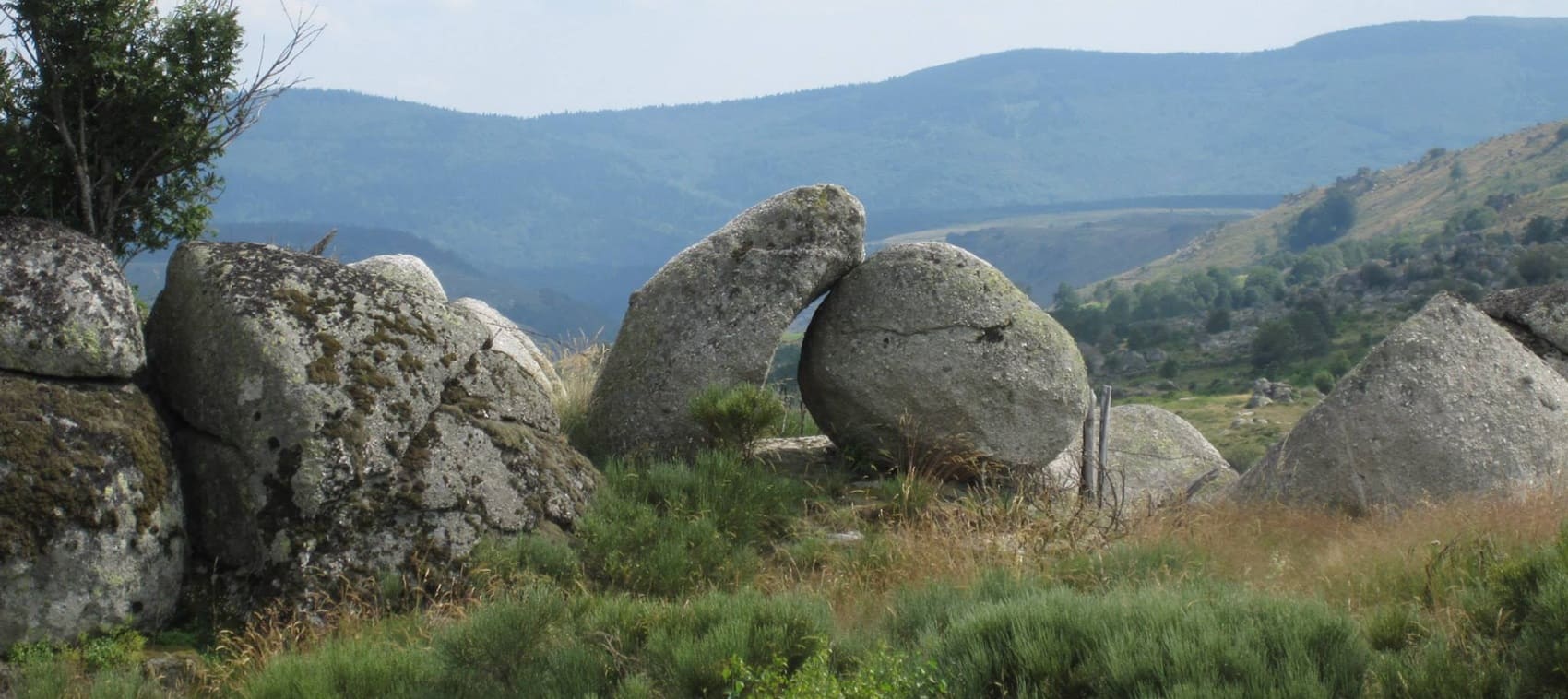
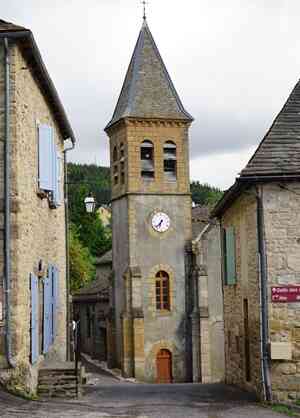 These are the Cevennes par excellence: the Cevennes of the Cevennes. In this inextricable labyrinth of mountains, a war of bandits, a war of ferocious beasts, raged for two years between the Great King with all his troops and marshals on one side, and several thousand Protestant mountain dwellers on the other. One hundred and eighty years ago, the Camisards held a post here, on the Lozère mountains where I am. They had an organization, arsenals, and a military and religious hierarchy. Their affairs were “the subject of all café conversations” in London.
These are the Cevennes par excellence: the Cevennes of the Cevennes. In this inextricable labyrinth of mountains, a war of bandits, a war of ferocious beasts, raged for two years between the Great King with all his troops and marshals on one side, and several thousand Protestant mountain dwellers on the other. One hundred and eighty years ago, the Camisards held a post here, on the Lozère mountains where I am. They had an organization, arsenals, and a military and religious hierarchy. Their affairs were “the subject of all café conversations” in London.
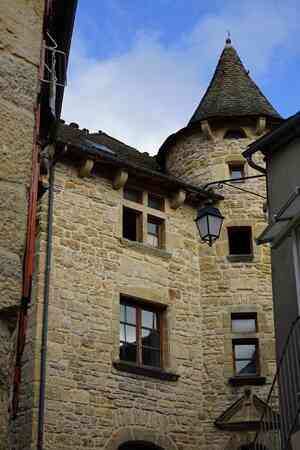 England sent fleets to support them. Their leaders prophesied and massacred. Behind banners and drums, singing old French psalms, their bands sometimes faced the light of day, marching to assault walled cities and putting the king's generals to flight. And sometimes, at night or masked, they occupied fortresses and took vengeance for the betrayal of their allies or exercised cruel reprisals on their enemies. Here, established one hundred and eighty years ago, was the chivalrous Roland, “the Count and Lord Roland, Generalissimo of the Protestants of France,” severe, taciturn, authoritative, a former dragon, marked by smallpox, whom a woman followed out of love in his wandering comings and goings.
England sent fleets to support them. Their leaders prophesied and massacred. Behind banners and drums, singing old French psalms, their bands sometimes faced the light of day, marching to assault walled cities and putting the king's generals to flight. And sometimes, at night or masked, they occupied fortresses and took vengeance for the betrayal of their allies or exercised cruel reprisals on their enemies. Here, established one hundred and eighty years ago, was the chivalrous Roland, “the Count and Lord Roland, Generalissimo of the Protestants of France,” severe, taciturn, authoritative, a former dragon, marked by smallpox, whom a woman followed out of love in his wandering comings and goings.
There was Cavalier, a baker's boy gifted with the genius of war, appointed brigadier of the Camisards at sixteen, to die at fifty-five as the English governor of Jersey. There was also Castanet, a partisan leader, under his voluminous wig and passionate about theological controversy. Strange generals who withdrew to the side to counsel with the God of Armies and refuse or accept battle, set sentinels or slept in a bivouac without guards, depending on how the Spirit inspired their hearts. And there were to follow them, as well as other leaders, crowds of prophets and disciples, bold, patient, tireless, brave to run in the mountains, charming their harsh existence with psalms, quick to fight, quick to pray, piously listening to the oracles of half-crazy children who mystically placed a grain of wheat among the lead balls with which they loaded their muskets.
Until this moment, I had traveled in a dreary region and in a wake where there was nothing more remarkable than the Beast of Gévaudan, Bonaparte of wolves, devourer of children. Now, I was about to approach a romantic chapter – or more precisely a romantic footnote – in universal history. What remained of all this dust and all these outdated heroics? I had been assured that Protestantism still survived in this headquarters of Huguenot resistance. Even a priest had affirmed it to me in the parlor of a convent. I still had to find out whether it was a survival or a fertile and living tradition. Furthermore, if in the northern Cevennes, people were strict in religious opinions and more filled with zeal than charity, what could I expect from these fields of persecution and reprisals? – in this region where the tyranny of the Church had provoked the revolt of the Camisards, and the terror of the Camisards had thrown the Catholic peasantry into a legal rebellion on the opposite side, so that Camisards and Florentines hid in the mountains to save their lives, both sides.
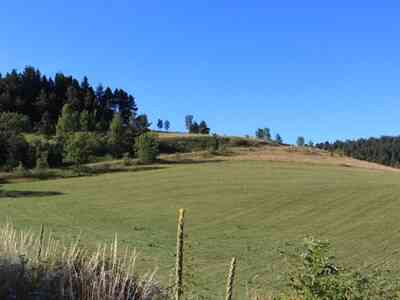 Just at the top of the mountain where I had paused to inspect the horizon before me, the series of stone markers suddenly ceased, and just a little below, a kind of path appeared, spiraling down a neck-breaking slope, turning like a corkscrew. It led into a valley between sloping hills, with rocky outcrops like a harvested wheat field and, towards the base, covered with a carpet of lush meadows.
Just at the top of the mountain where I had paused to inspect the horizon before me, the series of stone markers suddenly ceased, and just a little below, a kind of path appeared, spiraling down a neck-breaking slope, turning like a corkscrew. It led into a valley between sloping hills, with rocky outcrops like a harvested wheat field and, towards the base, covered with a carpet of lush meadows.
I hurried to follow the path: the steep nature of the slope, the continual and abrupt twists of the descent line, and the old invincible hope of finding something new in a new region all conspired to give me wings. A little further down, a stream began, gathering several springs and soon leading a joyful clamor among the mountains. Sometimes it wanted to cross the path in a semblance of a waterfall, with a ford where Modestine could cool her hooves.
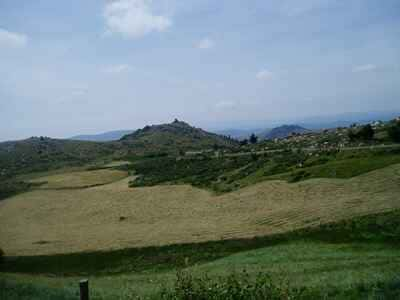 The entire descent felt like a dream to me, so quickly did it unfold. I had barely left the summit when the valley had already closed around my path and the sun shone directly down on me, as I walked in a stagnant atmosphere of lowlands. The path became a road. It descended and rose in gentle undulations. I passed one cabin, then another cabin, but everything seemed abandoned. I did not see a single human creature nor hear any noise, except for the sound of the stream. However, I had been, since the day before, in a different region.
The entire descent felt like a dream to me, so quickly did it unfold. I had barely left the summit when the valley had already closed around my path and the sun shone directly down on me, as I walked in a stagnant atmosphere of lowlands. The path became a road. It descended and rose in gentle undulations. I passed one cabin, then another cabin, but everything seemed abandoned. I did not see a single human creature nor hear any noise, except for the sound of the stream. However, I had been, since the day before, in a different region.
The stony skeleton of the world was here vigorously exposed to the sun and the elements. The slopes were steep and varied. Oaks clung to the mountains, strong, leafy, and touched by the autumn of bright and luminous colors. Here or there, some stream cascaded to the right or left down to the bottom of a ravine with round, snow-white, and chaotic stones.
At the bottom, the river (for it had quickly become a river collecting water from all sides as it followed its course) here for a moment foaming in desperate rapids, forming ponds of the most delightful sea green stained with liquid brown. No matter how far I had gone, I had never seen a river of such delicate and changing hue.
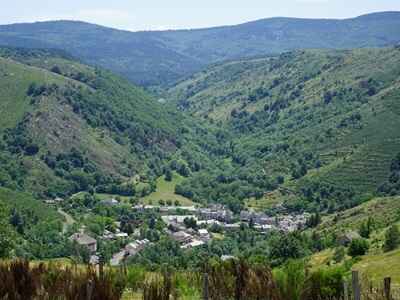 The crystal was not more transparent; the meadows were not even half as green, and at every pond I encountered, I felt a faint desire to rid myself of these warm, dusty clothes and bathe my naked body in the air and water of the mountains. As long as I live, I will never forget that it was a Sunday. The quietude was a perpetual "remember," and I could imagine the church bells ringing from all directions across Europe and the chanting of thousands of churches.
The crystal was not more transparent; the meadows were not even half as green, and at every pond I encountered, I felt a faint desire to rid myself of these warm, dusty clothes and bathe my naked body in the air and water of the mountains. As long as I live, I will never forget that it was a Sunday. The quietude was a perpetual "remember," and I could imagine the church bells ringing from all directions across Europe and the chanting of thousands of churches.
At the end, a human sound struck my ear – a strangely modulated cry, somewhere between emotion and mockery, and my gaze crossing the valley caught sight of a boy sitting in a meadow, his hands encircling his knees, shrunk by distance to a comic infinitesimal. The little funny fellow had spotted me as I descended the road, from oak wood to oak wood pulling Modestine, and he greeted me with compliments from the new region with his trembling high-pitched "hello." And just as all sounds are pleasant and natural from a sufficient distance, so was this one that reached me through the very pure mountain air and crossed the entire green valley, ringing delightfully in my ear and seeming to be a rustic being like the oaks and the river.
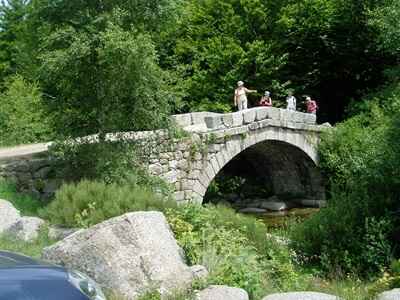 Shortly after, the stream I was following flowed into the Tarn, at Pont-de-Montvert, of bloody memory.
Shortly after, the stream I was following flowed into the Tarn, at Pont-de-Montvert, of bloody memory.
The Stevenson Path comes from Bleymard through
Mont Lozère and descends to Pont-de-Montvert before heading towards
Florac.
"One of the first things encountered at Pont-de-Montvert, if I remember
correctly, was the Protestant temple. But it was only the harbinger of other
novelties. A subtle atmosphere distinguishes a town in England from a town
in France or even in Scotland. In Carlisle, you can realize that you are
in a certain region. In Dumfries, thirty miles further, you are no less
certain to be in another. It would be difficult for me to express the
particularities that distinguish Pont-de-Montvert from Monastier sur
Gazeille or from Langogne, or even from Bleymard.
But the difference existed and spoke eloquently to the eyes. The locality, with
its houses, its paths, and its dazzling riverbed bears an indefinable southern stamp.
 Everything was Sunday bustle in the streets and in the cafés just as everything had been Sunday peace in the mountains. There must have been at least twenty people for lunch around eleven o'clock before noon.
Everything was Sunday bustle in the streets and in the cafés just as everything had been Sunday peace in the mountains. There must have been at least twenty people for lunch around eleven o'clock before noon.
When I had eaten and sat down to update my journal, I suppose several more arrived, one after another, or in groups of two or three. Crossing the Lozère mountains, not only had I arrived among certainly new faces, but I was also moving in the territory of a different race. These people, while they hurriedly finished their meats in an inextricable game of their knife blades, questioned me and answered me with a degree of intelligence that exceeded everything I had encountered so far, except among the railway workers in Chasseradès. They had faces that expressed frankness. They were lively in their words and manners. They not only entered into the total spirit of my excursion, but more than one assured me that if he had been fortunate enough, he would have loved to undertake such a journey.
Even physically, the transformation was pleasant. I had not seen a pretty woman since I left Monastier, and here was only one.
Now, of the three who were seated with me at dinner, one was certainly not beautiful — a poor shy creature of about forty, entirely disturbed by the noise of the guest table, of whom I was the knight servant, serving her up to and including the wine, encouraging her to drink, generally trying to encourage her. With a result that was, however, exactly the opposite. But the other two, both married, were both more distinguished than the average women.
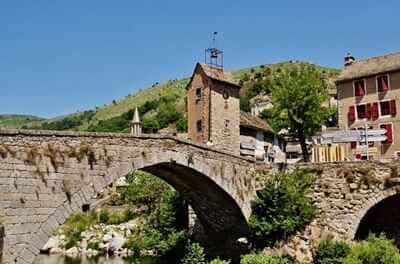 And Clarisse? What can be said about Clarisse? She served at the table with an impassive and nonchalant heaviness that had something bovine about it. Her immense grayish eyes were drowned in love's languor. Her features, though somewhat plump, had an original and fine design. Her lips had a curve of disdain. Her nostrils indicated a ceremonial pride. Her cheeks fell in bizarre and typical contours. She had a face capable of deep emotion and, with training, promised delicate feelings. It seemed deplorable to see such an excellent model abandoned to local admiration and to local ways of thinking.
And Clarisse? What can be said about Clarisse? She served at the table with an impassive and nonchalant heaviness that had something bovine about it. Her immense grayish eyes were drowned in love's languor. Her features, though somewhat plump, had an original and fine design. Her lips had a curve of disdain. Her nostrils indicated a ceremonial pride. Her cheeks fell in bizarre and typical contours. She had a face capable of deep emotion and, with training, promised delicate feelings. It seemed deplorable to see such an excellent model abandoned to local admiration and to local ways of thinking.
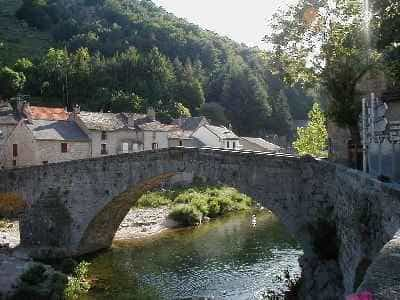 A new road leads from Pont-de-Montvert to Florac, through the Tarn valley. Its soft sandy base develops about halfway between the summit of the mountains and the river at the bottom of the valley. And I entered to come out, alternately, under golf courses of shadows and sunlit promontories in the afternoon.
A new road leads from Pont-de-Montvert to Florac, through the Tarn valley. Its soft sandy base develops about halfway between the summit of the mountains and the river at the bottom of the valley. And I entered to come out, alternately, under golf courses of shadows and sunlit promontories in the afternoon.
It was a passage similar to that of Killiecrankie, a deep funnel-shaped ravine in the mountains, with the Tarn leading a wonderfully wild rumble below, and steep heights in the sunlight above. A narrow border of ashes circled the peaks of the mountains like ivy on ruins.
On the lower slopes and beyond each gorge, chestnut trees, in groups of four, rose to the sky under their spread foliage. Some were planted on individual terraces no wider than a bed; others, confident in their roots, found a way to grow, to develop, to remain upright and bushy on the steep slopes of the valley.
Others, on the riverbanks, stood lined up in battle formation, powerful like the cedars of Lebanon. Yet, even where they grew in a tight mass, they did not resemble a forest, but rather a troupe of athletes. And the dome of each of these trees spread out, isolated and vast among the domes of its companions, as if it were itself a small eminence. They released a scent of light sweetness that drifted in the afternoon air.
" From "Journey with a Donkey in the Cevennes"
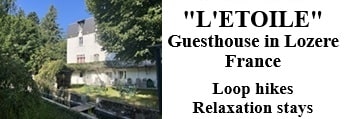
Former holiday hotel with a garden along the Allier, L'Etoile Guest House is located in La Bastide-Puylaurent between Lozere, Ardeche, and the Cevennes in the mountains of Southern France. At the crossroads of GR®7, GR®70 Stevenson Path, GR®72, GR®700 Regordane Way, GR®470 Allier River springs and gorges, GRP® Cevenol, Ardechoise Mountains, Margeride. Numerous loop trails for hiking and one-day biking excursions. Ideal for a relaxing and hiking getaway.
Copyright©etoile.fr

 These are the Cevennes par excellence: the Cevennes of the Cevennes. In this inextricable labyrinth of mountains, a war of bandits, a war of ferocious beasts, raged for two years between the Great King with all his troops and marshals on one side, and several thousand Protestant mountain dwellers on the other. One hundred and eighty years ago, the Camisards held a post here, on the Lozère mountains where I am. They had an organization, arsenals, and a military and religious hierarchy. Their affairs were “the subject of all café conversations” in London.
These are the Cevennes par excellence: the Cevennes of the Cevennes. In this inextricable labyrinth of mountains, a war of bandits, a war of ferocious beasts, raged for two years between the Great King with all his troops and marshals on one side, and several thousand Protestant mountain dwellers on the other. One hundred and eighty years ago, the Camisards held a post here, on the Lozère mountains where I am. They had an organization, arsenals, and a military and religious hierarchy. Their affairs were “the subject of all café conversations” in London. England sent fleets to support them. Their leaders prophesied and massacred. Behind banners and drums, singing old French psalms, their bands sometimes faced the light of day, marching to assault walled cities and putting the king's generals to flight. And sometimes, at night or masked, they occupied fortresses and took vengeance for the betrayal of their allies or exercised cruel reprisals on their enemies. Here, established one hundred and eighty years ago, was the chivalrous Roland, “the Count and Lord Roland, Generalissimo of the Protestants of France,” severe, taciturn, authoritative, a former dragon, marked by smallpox, whom a woman followed out of love in his wandering comings and goings.
England sent fleets to support them. Their leaders prophesied and massacred. Behind banners and drums, singing old French psalms, their bands sometimes faced the light of day, marching to assault walled cities and putting the king's generals to flight. And sometimes, at night or masked, they occupied fortresses and took vengeance for the betrayal of their allies or exercised cruel reprisals on their enemies. Here, established one hundred and eighty years ago, was the chivalrous Roland, “the Count and Lord Roland, Generalissimo of the Protestants of France,” severe, taciturn, authoritative, a former dragon, marked by smallpox, whom a woman followed out of love in his wandering comings and goings. Just at the top of the mountain where I had paused to inspect the horizon before me, the series of stone markers suddenly ceased, and just a little below, a kind of path appeared, spiraling down a neck-breaking slope, turning like a corkscrew. It led into a valley between sloping hills, with rocky outcrops like a harvested wheat field and, towards the base, covered with a carpet of lush meadows.
Just at the top of the mountain where I had paused to inspect the horizon before me, the series of stone markers suddenly ceased, and just a little below, a kind of path appeared, spiraling down a neck-breaking slope, turning like a corkscrew. It led into a valley between sloping hills, with rocky outcrops like a harvested wheat field and, towards the base, covered with a carpet of lush meadows. The entire descent felt like a dream to me, so quickly did it unfold. I had barely left the summit when the valley had already closed around my path and the sun shone directly down on me, as I walked in a stagnant atmosphere of lowlands. The path became a road. It descended and rose in gentle undulations. I passed one cabin, then another cabin, but everything seemed abandoned. I did not see a single human creature nor hear any noise, except for the sound of the stream. However, I had been, since the day before, in a different region.
The entire descent felt like a dream to me, so quickly did it unfold. I had barely left the summit when the valley had already closed around my path and the sun shone directly down on me, as I walked in a stagnant atmosphere of lowlands. The path became a road. It descended and rose in gentle undulations. I passed one cabin, then another cabin, but everything seemed abandoned. I did not see a single human creature nor hear any noise, except for the sound of the stream. However, I had been, since the day before, in a different region.  The crystal was not more transparent; the meadows were not even half as green, and at every pond I encountered, I felt a faint desire to rid myself of these warm, dusty clothes and bathe my naked body in the air and water of the mountains. As long as I live, I will never forget that it was a Sunday. The quietude was a perpetual "remember," and I could imagine the church bells ringing from all directions across Europe and the chanting of thousands of churches.
The crystal was not more transparent; the meadows were not even half as green, and at every pond I encountered, I felt a faint desire to rid myself of these warm, dusty clothes and bathe my naked body in the air and water of the mountains. As long as I live, I will never forget that it was a Sunday. The quietude was a perpetual "remember," and I could imagine the church bells ringing from all directions across Europe and the chanting of thousands of churches. Shortly after, the stream I was following flowed into the Tarn, at Pont-de-Montvert, of bloody memory.
Shortly after, the stream I was following flowed into the Tarn, at Pont-de-Montvert, of bloody memory. Everything was Sunday bustle in the streets and in the cafés just as everything had been Sunday peace in the mountains. There must have been at least twenty people for lunch around eleven o'clock before noon.
Everything was Sunday bustle in the streets and in the cafés just as everything had been Sunday peace in the mountains. There must have been at least twenty people for lunch around eleven o'clock before noon. And Clarisse? What can be said about Clarisse? She served at the table with an impassive and nonchalant heaviness that had something bovine about it. Her immense grayish eyes were drowned in love's languor. Her features, though somewhat plump, had an original and fine design. Her lips had a curve of disdain. Her nostrils indicated a ceremonial pride. Her cheeks fell in bizarre and typical contours. She had a face capable of deep emotion and, with training, promised delicate feelings. It seemed deplorable to see such an excellent model abandoned to local admiration and to local ways of thinking.
And Clarisse? What can be said about Clarisse? She served at the table with an impassive and nonchalant heaviness that had something bovine about it. Her immense grayish eyes were drowned in love's languor. Her features, though somewhat plump, had an original and fine design. Her lips had a curve of disdain. Her nostrils indicated a ceremonial pride. Her cheeks fell in bizarre and typical contours. She had a face capable of deep emotion and, with training, promised delicate feelings. It seemed deplorable to see such an excellent model abandoned to local admiration and to local ways of thinking. A new road leads from Pont-de-Montvert to Florac, through the Tarn valley. Its soft sandy base develops about halfway between the summit of the mountains and the river at the bottom of the valley. And I entered to come out, alternately, under golf courses of shadows and sunlit promontories in the afternoon.
A new road leads from Pont-de-Montvert to Florac, through the Tarn valley. Its soft sandy base develops about halfway between the summit of the mountains and the river at the bottom of the valley. And I entered to come out, alternately, under golf courses of shadows and sunlit promontories in the afternoon.